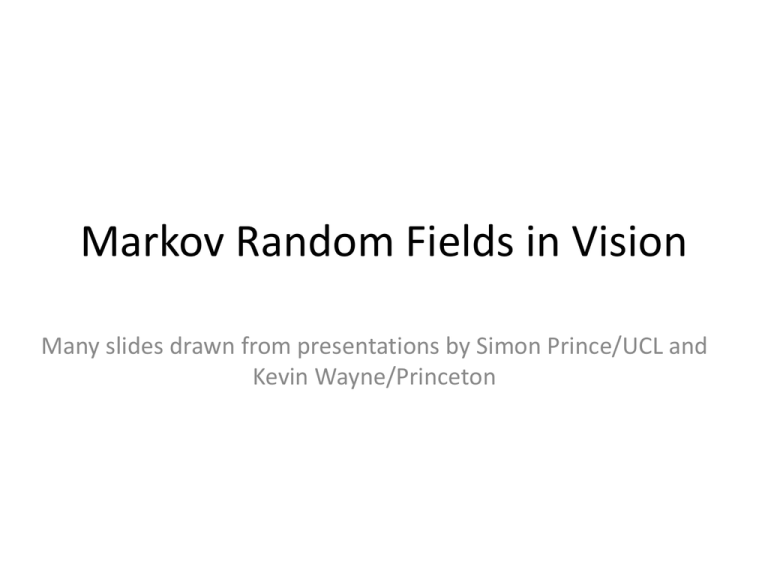
Markov Random Fields in Vision
Many slides drawn from presentations by Simon Prince/UCL and
Kevin Wayne/Princeton
Image Denoising
Foreground Extraction
Stereo Disparity
Why study MRFs?
• Image denoising is based on modeling what
kinds of images are more probable
• Foreground extraction is based on modeling
what spatial distribution of foreground pixels
is more probable
• Stereo disparity estimation is based on
modeling what kinds of disparity fields are
more probable
Modeling the joint probability
distribution
• Associate a random variable with each pixel
Conditional independence
assumptions necessary for tractability
• Directed graphical models (a.k.a Bayes nets,
Belief networks)
MRF Definition
Example: Image with 4-connected pixels
Hammersley Clifford Theorem
Any positive distribution that obeys the Markov property
can be written in the form
Where the c terms are maximal
cliques
Cliques = subsets of variables that all
connect to each other.
Maximal = cannot add any more
variables and still be a clique
MRF on a line which favors smoothness
Consider the case where variables are binary, so functions return 4 different
values depending on the combination of neighbours. Let’s choose
Denoising with MRFs
MRF Prior (pairwise cliques)
Original image, y
Likelihoods
Observed image, x
Inference via Bayes’ rule:
MAP Inference
Unary terms
(compatibility of data with label y)
Pairwise terms
(compatibility of neighboring labels)
Graph Cuts Overview
Graph cuts used to optimise this cost function:
Unary terms
(compatibility of data with label y)
Three main cases:
Pairwise terms
(compatibility of neighboring labels)
Graph Cuts Overview
Graph cuts used to optimise this cost function:
Unary terms
(compatibility of data with label y)
Pairwise terms
(compatibility of neighboring labels)
Approach:
Convert minimization into the form of a standard CS problem,
MAXIMUM FLOW or MINIMUM CUT ON A GRAPH
Low order polynomial methods for solving this problem are known
Chapter 7
Network Flow
Slides by Kevin Wayne.
Copyright © 2005 Pearson-Addison Wesley.
All rights reserved.
14
Minimum Cut Problem
Flow network.
Abstraction for material flowing through the edges.
G = (V, E) = directed graph, no parallel edges.
Two distinguished nodes: s = source, t = sink.
c(e) = capacity of edge e.
n
n
n
n
10
source
s
capacity
5
15
2
9
5
4
15
15
10
3
8
6
10
4
6
15
4
30
7
t
sink
10
15
Cuts
Def. An s-t cut is a partition (A, B) of V with s A and t B.
Def. The capacity of a cut (A, B) is:
cap( A, B) =
å c(e)
e out of A
10
s
5
2
9
5
4
15
15
10
3
8
6
10
4
6
15
t
A
15
4
30
7
10
Capacity = 10 + 5 + 15
= 30
16
Cuts
Def. An s-t cut is a partition (A, B) of V with s A and t B.
Def. The capacity of a cut (A, B) is:
cap( A, B) =
å c(e)
e out of A
10
5
s
A
15
2
9
5
4
15
15
10
3
8
6
10
4
6
15
4
30
7
t
10
Capacity = 9 + 15 + 8 + 30
= 62
17
Minimum Cut Problem
Min s-t cut problem. Find an s-t cut of minimum capacity.
10
5
s
A
15
2
9
5
4
15
15
10
3
8
6
10
4
6
15
4
30
7
t
10
Capacity = 10 + 8 + 10
= 28
18
Flows
Def. An s-t flow is a function that satisfies:
For each e E:
0 £ f (e) £ c(e)
For each v V – {s, t}: å f (e) = å f (e)
(capacity)
(conservation)
n
n
e in to v
e out of v
Def. The value of a flow f is: v( f ) =
å f (e) .
e out of s
0
2
4
10
4 4
0
5
s
9
0
15
5
0
15
0
4
4
3
8
6
0
capacity
15
flow
0
4 0
6
15 0
0
4
30
10
7
10
t
0
10
Value = 4
19
Flows
Def. An s-t flow is a function that satisfies:
For each e E:
0 £ f (e) £ c(e)
For each v V – {s, t}: å f (e) = å f (e)
(capacity)
(conservation)
n
n
e in to v
e out of v
Def. The value of a flow f is: v( f ) =
å f (e) .
e out of s
6
2
10
10
4 4
3
5
s
9
0
15
5
6
15
0
8
8
3
8
6
1
capacity
15
flow
11
4 0
6
15 0
11
4
30
10
7
10
t
10
10
Value = 24
20
Maximum Flow Problem
Max flow problem. Find s-t flow of maximum value.
9
2
10
10
4 0
4
5
s
9
1
15
5
9
15
0
9
8
3
8
6
4
capacity
15
flow
14
4 0
6
15 0
14
4
30
10
7
10
t
10
10
Value = 28
21
Flows and Cuts
Flow value lemma. Let f be any flow, and let (A, B) be any s-t cut.
Then, the net flow sent across the cut is equal to the amount leaving s.
å f (e) - å f (e) = v( f )
e out of A
e in to A
6
2
10
10
4 4
3
s
5
9
0
15
5
6
15
0
8
8
3
A
8
6
1
15
4 0
11
6
15 0
11
4
30
10
7
10
t
10
10
Value = 24
22
Flows and Cuts
Flow value lemma. Let f be any flow, and let (A, B) be any s-t cut.
Then, the net flow sent across the cut is equal to the amount leaving s.
å f (e) - å f (e) = v( f )
e out of A
e in to A
6
2
10
10
4 4
3
s
5
9
0
15
5
6
15
0
8
8
3
A
8
6
1
15
4 0
11
6
15 0
11
4
30
10
7
10
t
10
10
Value = 6 + 0 + 8 - 1 + 11
= 24
23
Flows and Cuts
Flow value lemma. Let f be any flow, and let (A, B) be any s-t cut.
Then, the net flow sent across the cut is equal to the amount leaving s.
å f (e) - å f (e) = v( f )
e out of A
e in to A
6
2
10
10
4 4
3
s
5
9
0
15
5
6
15
0
8
8
3
A
8
6
1
15
4 0
11
6
15 0
11
4
30
10
7
10
t
10
10
Value = 10 - 4 + 8 - 0 + 10
= 24
24
Max-Flow Min-Cut Theorem
Max-flow min-cut theorem. [Ford-Fulkerson 1956] The value of the
max flow is equal to the value of the min cut.
There are low order polynomial time algorithms known for determining
these, and associated software is available
25
Graph Cuts: Binary MRF
Graph cuts used to optimise this cost function:
Unary terms
(compatability of data with label y)
Pairwise terms
(compatability of neighboring labels)
First work with binary case (i.e. True label y is 0 or 1)
Constrain pairwise costs so that they are “zero-diagonal”
Graph Construction
•
•
•
•
One node per pixel (here a 3x3 image)
Edge from source to every pixel node
Edge from every pixel node to sink
Reciprocal edges between neighbours
Note that in the minimum cut
EITHER the edge connecting to
the source will be cut, OR the
edge connecting to the sink, but
NOT BOTH (unnecessary).
Which determines whether we
give that pixel label 1 or label 0.
Now a 1 to 1 mapping between
possible labelling and possible
minimum cuts
Graph Construction
Now add capacities so that
minimum cut, minimizes our cost
function
Unary costs U(0), U(1) attached
to links to source and sink.
•
Either one or the other is paid.
Pairwise costs between pixel
nodes as shown.
•
Why? Easiest to understand
with some worked examples.
Example 1
Example 2
Graph Cuts: Binary MRF
Graph cuts used to optimise this cost function:
Unary terms
(compatability of data with label y)
Pairwise terms
(compatability of neighboring labels)
Summary of approach
•
•
•
Associate each possible solution with a minimum cut on a graph
Set capacities on graph, so cost of cut matches the cost function
This minimizes the cost function and finds the MAP solution
Image Denoising
Foreground Extraction
Stereo Disparity
The connection between graph cuts and
MRF inference was first made in this paper





